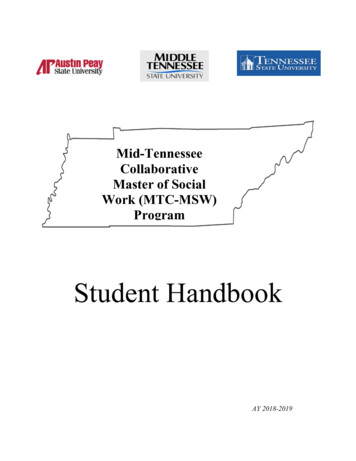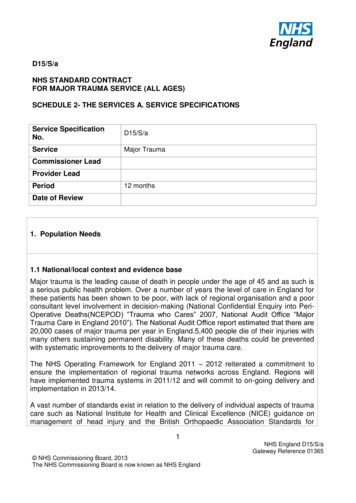
Transcription
2015 COST INCOME TAXCONFERENCEMemphis, TennesseeThe MTC ALAS Project and the GrowingInterest in Transfer Pricing at the Stateand Local LevelJeffrey M. VeselyLoren C. PondsPartnerPillsbury Winthrop Shaw PittmanSan Francisco, CASenior ManagerErnst & Young LLPWashington, DCKarl FriedenVice President and General CounselCouncil On State TaxationWashington DCCouncil On State Taxation
Learning ObjectivesWhat is the MTC ALAS Project?Which States Are Involved?Why Are States Interested in Transfer Pricing?Why Is This Project Important?What is the Latest On the DC Transfer Pricing Cases?What is the Importance of Transfer Pricing?What Impact Might the BEPS TP‐Related Items Have on State Transfer Pricing?Council On State Taxation2
MTC ARM’S LENGTH ADJUSTMENTSERVICE (“ALAS”) PROJECT May 2013—Genesis of Project MTC Executive Committee Meeting Michael Bryan NJ Director of Taxation June 2014—ALAS Advisory Group InitialMeeting Dan Bucks, Former MTC Executive Director andDirector of Montana Department of Revenue isProject FacilitatorCouncil On State Taxation3
MTC ALAS PROJECT Series of Meetings of Advisory Group andVarious Iterations of Advisory Group’sRecommend Approach October 2014—Meeting with Third PartyTransfer Pricing Experts RFP Issued for Training Proposal February 2015—Solicitation Letters Sent byJoe Huddleston to 45 States and DC 4 Year CommitmentCouncil On State Taxation4
MTC ALAS PROJECT March 31‐April 1, 2015—Training Conductedfor 10 States by Third Party Contractor Ednaldo Silva, Former Senior Economic Advisorwith Office of IRS Chief Counsel and Part of TeamWhich Drafted the IRC 482 Regulations Attendees Included Alabama, Connecticut,Florida, Georgia, Iowa, Kentucky, Louisiana, NewJersey, North Carolina and PennsylvaniaCouncil On State Taxation5
MTC ALAS PROJECT May 2015—MTC Will Seek Approval From ItsExecutive Committee to Move Forward 7 States Need To Commit 4 Year Charter Period (July 2015-June 2019)Council On State Taxation6
HIGHLIGHTS OF ALAS PROJECT Provide Interrelated Service Elements Trainingo Analysis of Transfer Pricing Studies State Capacity Buildingo Beyond Formal Trainingo Exchange of Information Among States Individual Audits by MTC Optional Joint AuditsCouncil On State Taxation7
HIGHLIGHTS OF ALAS PROJECT Staffing of Project Over the Charter Period, it is Projected that ALAS WillHire Three Economists, an Attorney, a Tax Manager and aPricing Auditor ALAS Will Also Use Third Party Consultants Budget FY 2016-- 1.25MM FY 2017-- 2.25MM FY 2018-- 2.213MM FY 2019-- 1.954MMCouncil On State Taxation8
HIGHLIGHTS OF ALAS PROJECT Costs to States to Participate 4 Year Commitmento Possible exceptions Will Vary by Stateo How State Uses the Programo Number of Participant Stateso Size of State in Terms of Corporate Tax Revenue Approximately 200,000 Per Year Per StateEstimated Revenues 110MM Over the 4 Year Charter PeriodCouncil On State Taxation9
HIGHLIGHTS OF ALAS PROJECT Timeline FY 2016 (July 2015-June 2016)o Launcho Developmental Stage FY 2017 (July 2016-June 2017)o Developmental Stage FY 2018 (July 2017-June 2018)o Fully Operational FY 2019 (July 2018-June 2019)o Fully OperationalCouncil On State Taxation10
WHICH STATES ARE INVOLVED? Principally Separate Filing States Alabama, Connecticut, Florida, Georgia, Iowa, Kentucky,Louisiana, New Jersey, North Carolina, Pennsylvania Some Combined Reporting States District of Columbia, Hawaii April 7, 2015—4 States Have Expressed an Interest inCommitting Alabama, Iowa, New Jersey and North Carolina 21 States Have Thus Far Responded to Huddleston’sLetterCouncil On State Taxation11
WHY STATES ARE INTERESTED INTRANSFER PRICING ALAS Advisory Group Preliminary Design “Why States Need to Act” States Face Major Fiscal Problems Due toBusinesses Shifting Income to More FavorableJurisdictions Significant Lost Revenues Per U.S. PIRG/CitizensFor Tax Justiceo Federal Estimate-- 100Bo State Estimate-- 20BCouncil On State Taxation12
MTC’S PERSPECTIVE ON WHYSTATES NEED TO ACT Uneven Playing Field for Industry Unfair Shifts of Public Service Costs to OtherTaxpayers Loss of Societal TrustCouncil On State Taxation13
MTC’S PERSPECTIVE ON WHYSTATES NEED TO ACT States Are Ill‐Equipped to DifferentiateBetween Proper and Improper IncomeShifting Cost is Prohibitive for States to Deal WithThese Issues Individually Pool Their ResourcesCouncil On State Taxation14
MTC’S PERSPECTIVE ON WHYSTATES NEED TO ACT Typical Transactions Identified Transfers/Licensing of IP Purchase and Resale of Tangible Goods Providing and Charging for Common Services Stripping Earnings Out of States Through FinancingArrangements Factoring Accounts Receivables Utilizing “Embedded Royalties”—Including Charge for Useof Intangibles in Payment for Goods/ServicesCouncil On State Taxation15
WHY COMPANIES ARE CLOSELYWATCHING THE ALAS PROJECT Transfer Pricing Issues Arise With Respect to In‐Bound andOut‐Bound Transactions Between Related Parties Transfer Pricing Issues Arise With Respect to Interstate andForeign Transactions Between Related Parties Transfer Pricing Issues Not Limited to Separate Filing States In Combined Reporting States, Related Party TransactionsBetween Entities in Combined Report and Those Outsidethe Combined Report Are ExaminedooE.g., Water’s Edge Combined ReportsCalifornia Devotes Over 200 Pages of its Water’s Edge Manual toTransfer Pricing IssuesCouncil On State Taxation16
LATEST ON DC TRANSFER PRICINGLITIGATION OTR Uses Chainbridge in its Transfer Pricing Audits Contingent Fee Alabama, Louisiana and New JerseyMicrosoft (2012) OAH Held That Chainbridge’s Transfer Pricing Analysis was Arbitrary,Capricious and Unreasonable Summary Judgment Granted for Taxpayer Appeal by OTR WithdrawnBP (2013) Superior Court Held That Validity of Chainbridge’s Method InvolvedQuestions of Law and Fact Denied Taxpayer’s SJ motion Case SettledCouncil On State Taxation17
LATEST ON DC TRANSFER PRICINGLITIGATION Exxon, Shell and Hess (2014) OAH Held That OTR Barred by Collateral Estoppelfrom Relitigating Chainbridge Method Issue Dueto Microsoft Case On Appeal Ahold, AT&T Services, Eli Lilly andExxonMobil (2015) Litigations Stayed Pending Collateral EstoppelAppealCouncil On State Taxation18
TRANSFER PRICING IN THEINTERNATIONAL CONTEXT “Transfer pricing” means the prices at whichrelated parties within a multinationalenterprise (“MNE”) transfer goods, servicesand intangible property among one another Transfer pricing impacts the income taxliabilities of the affiliates within the MNE, andthus, the after-tax profitability of the entireenterpriseCouncil On State Taxation19
TRANSFER PRICING BASICS:CONCEPTS Control – Treas. Reg. § 1.482-1(i)(4) definition;presumption of control with arbitrary incomeshifting; B. Forman Arm’s length standard – cornerstone concept Best method rule – no hierarchy of methods Comparability – functions, risks, assets, contractualterms, economic & financial conditions Arm’s length range – from comparables;interquartile range for increased reliability of resultsCouncil On State Taxation20
TRANSFER PRICING BASICS: METHODSTangible propertyIntangible propertyServicesCUP(Comparable UncontrolledPrice Method)CUT(Comparable UncontrolledTransaction Method)CUSP(Comparable UncontrolledServices Price Method)RPM(Resale Price Method)–GSM(Gross Services Margin Method)Cost Plus(Cost Plus Method)–CSPM(Cost of Services Plus Method)CPM(Comparable Profits Method)(cf. to TNMM in OECD Guidelines)(Transactional Net Margin Method)CPM / TNMM(Commensurate with income rules)CPMPSM(Profit Split Method)PSMPSMCPS(Comparable ProfitSplit Method)RPS(Residual ProfitSplit Method)Unspecified MethodsCPSRPSUnspecified MethodsIncome method –(coordinationwith 482-7T)CPSRPS-SCM(Services Cost Method)–Council On State Taxation21
WHY IS TRANSFER PRICING IMPORTANT?Transfer pricing planning opportunityParent(Country A)Sub(Country B)ConsolidatedTotal profit reported on tax return7003001,000Tax rate40%10%Tax liability before change to transfer price28030Global Effective Tax Rate (“ETR”)31031%Effect of Transfer pricing change on ETRTotal profit after using transfer pricing to shift 400 of income300700Tax rate40%10%Tax liability after change to transfer price12070Global ETR1,00019019%Council On State Taxation22
WHY IS TRANSFER PRICING IMPORTANT?Exposure to double taxationParent(Country A)Sub(Country B)ConsolidatedTotal profit reported on tax return3007001,000Tax rate40%10%Tax liability before Country B transfer pricing adjustment12070Global Effective Tax Rate (“ETR”)19019%Double taxation effect on ETRTotal profit after adjustment (increase in profits) by Country A of 400(assumes no correlative relief in B)700700Tax rate40%10%Tax liability after Country A transfer pricing adjustment (penaltiesand interest not included)28070Global ETR1,40035035%Council On State Taxation23
WHY IS TRANSFER PRICINGIMPORTANT? Governmental interest The related party aspect of the transactionssuspends the normal laws of supply and demand Without IRC § 482 and similar statues in othercountries, related parties could artificially shiftincome to achieve tax benefits Tax rate differential – IRS perspective Intense focus on transfer pricing enforcementCouncil On State Taxation24
WHY IS TRANSFER PRICINGIMPORTANT? Three core strategies: Better case selection, development and presentationo “Take back the audit process”o Focus more on issues, less on taxpayers - IPNso TPP audit road mapo Information Document Request (IDR) directives Revise technical rules to support rational economic outcomeso Section 367(d) regulatory projecto OECD projects (e.g., Chapter 6 revisions, Base Erosion andProfit Shifting (BEPS) project)o US international tax reform Win in litigation to rebalance perceived hazardsCouncil On State Taxation25
OECD BEPS ACTION PLAN – TP‐RELATED TOPICSAction Item 8: Transfer pricing for intangibles – September2014/September 2015Action Item 9: Transfer pricing for risks and capital – September2015Action Item 10: Transfer pricing for other high‐risktransactions – September 2015Action Item 13: Transfer pricing documentation – September2014Action Item 14: Effectiveness of treaty dispute resolutionmechanisms – September 2015Council On State Taxation26
BEPS ACTION ITEM 8 – TRANSFERPRICING FOR INTANGIBLES The recommendations under Action 8 contain revised standards for transferpricing of intangibles, including additional standards for comparability and transferpricing methodsThe recommendations include amendments to Chapter 1 of the OECD TransferPricing Guidelines to address the treatment of location savings and other marketfeatures, assembled workforce, and MNC group synergiesThe main element of the recommendations is a revised Chapter VI on intangibles,which includes guidance on:o The definition of intangibleso Identifying and characterizing controlled transactions involvingintangibleso Determining arm’s length conditions for transactions involving intangiblesThe recommendations also include guidance on determining ownership ofintangibles and entitlement to an intangible related return, which is not yetagreed and which will be finalized in connection with the 2015 work on Action 9on transfer pricing for risk (“special measures”)Council On State Taxation27
BEPS ACTION ITEMS 9 and 10 – TRANSFERPRICING FOR RISKS AND CAPITAL AND OTHERHIGH‐RISK TRANSACTIONS TP guidance for low value-adding services to provide protectionagainst common types of base eroding payments (managementfees and head office expenses) Carryover work from Action Item 8: adopting TP rules/specialmeasures to clarify situations wherein transactions can berecharacterized (Draft issued 12/2014) Developing rules on use of profit splits in the context of globalvalue chains Adopting TP rules with respect to cross-border commoditytransactions The OECD has received extensive comments on these documentsand a public consultation is scheduled for 19-20 March 2015Council On State Taxation28
BEPS ACTION ITEM 13 – TP DOCUMENTATIONAND COUNTRY BY COUNTRY REPORTING The recommendations under Action 13 contain revised standards for transfer pricingdocumentation and a template for country-by-country (“CbC”) reporting to be includedin the OECD Transfer Pricing GuidelinesThe CbC reporting template will require MNCs to report the following items annuallyfor each country where they have an entity or permanent establishment: Revenue, related and unrelated party Profits Income tax paid and taxes accrued Stated capital and retained earnings Employees Tangible assets Also identification of each entity in the country and the business activities of eachentityThe transfer pricing documentation framework is a master file/local file approachThe OECD on 6 February 2015 announced agreement on some key implementationissues, including timing, delivery mechanisms, and conditions for useCouncil On State Taxation29
BEPS ACTION ITEM 13 – TP DOCUMENTATIONAND COUNTRY BY COUNTRY REPORTING Under agreement on implementation of CbC reporting: First CbC reports are to cover 2016 fiscal years, with filing requiredwithin 12 months of year end CbC report generally is to be delivered to the MNC parent entity’shome country and shared with other relevant countries undergovernment information exchange mechanismso Secondary delivery mechanisms contemplated for situationswhere home country does not have CbC reporting mechanismo Exchange mechanism to include confidentiality protections Exemption from CbC reporting for MNC groups with annual turnoverof less than 750 millionMaster file and local file to be delivered to local countries under localimplementation guidanceModel implementation language to be developedCouncil On State Taxation30
WHAT DOES THIS MEAN FOR STATES? Are states going to follow through with developing resourcesdedicated to transfer pricing?To what extent will states’ efforts be enhanced by informationsharing from the IRS? Information sharing – electronic files from IRS from CbCreporting entitiesIs attention being drawn by the OECD’s BEPS project going toaccelerate the states’ activities?Separate return states vs. consolidated/combined return states –variances to the approach What is the impact for consolidated/combined return states? Separate return states can mirror Treas. Reg. §1.482 approachCouncil On State Taxation31
Questions?Jeffrey M. VeselyLoren C. law.comErnst & Young LLP202.327.8758loren.ponds@ey.comKarl FriedenCOST202.484.5215kfrieden@cost.orgCouncil On State Taxation32
Pricing Guidelines to address the treatment of location savings and other market features, assembled workforce, and MNC group synergies The main element of the recommendations is a revised Chapter VI on intangibles, which includes guidance on: o The definition of intangibles o Identifying and characterizing controlled transactions involving










